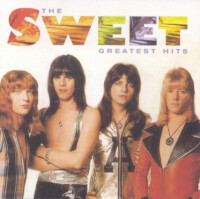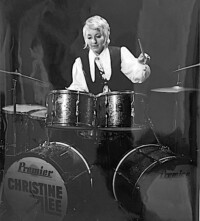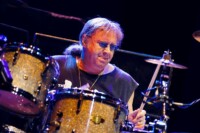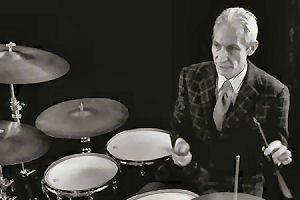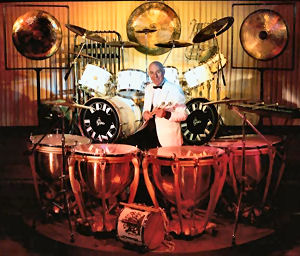I used to bump into Max Weinberg every now and again when we were touring around in my Kinks days and doing the odd gig with Bruce Springsteen. I’m pretty sure I remember playing with him in a street festival in Belgium when I was in a band called GB Blues Company, but he wasn’t playing with Bruce Springsteen at that time. I’m thinking he was touring Europe with Nils Lofgren. His playing life has been inextricably linked with ‘The Boss’ since 1974 when he passed the audition for what became a very serious and prestigious gig.
To get to the beginning, Max was born on April 13, 1951 to a Jewish family in Newark, New Jersey. His parents were Bertram Weinberg, an attorney, and Ruth Weinberg, a high school physical education teacher. He has three sisters and grew up variously in Newark and the nearby suburban towns of South Orange and Maplewood.
Max was exposed to music early on and attended Broadway shows weekly from the age of two, liking the big sound the pit orchestras put out. We’re told he also liked Country and Western music and knew he wanted to be a drummer at the age of five, when he saw Elvis Presley and his drummer, D. J. Fontana, appearing on television. This was in April 1956 and was something of a ‘moment’. He spoke of it later saying “I think anybody who wanted to develop a life in rock ‘n’ roll music had a moment. That was my moment”.
DJ Fontana became a major influence on him and he consequently received a child’s conga from his father after they watched a TV show featuring famous Latin-American bandleader Xavier Cugat.
Weinberg has also acknowledged The Ventures as a major influence on him and to celebrate that band’s 30th anniversary he actually sat in on drums with them.
Max started actually playing drums at the age of six and his first public appearance came a year later when he sat in with a bar mitzvah band playing “When the Saints Go Marching In”. This band was much in demand for Jewish bar mitzvahs and weddings in the area. The leader was impressed with the young Weinberg and brought him along on other engagements as a kind of novelty act. This lead to Max becoming a local child-star, drumming in a three-piece mohair suit. He learned to appreciate showmanship and was impressed by Liberace and Sammy Davis, Jr. and idolised Buddy Rich and Gene Krupa. He saw (our recent subject) Ed Shaughnessy in Doc Severinsen’s band on The Tonight Show Starring Johnny Carson and felt Ed had the ideal job. He also greatly admired their level of playing and the serious sartorial style of the Tonight Show musicians.
Weinberg stayed with that function band until junior high school and during that time took on board its various decidedly non-rock ‘n’ roll rhythms: Cha-chas, meringues, polkas, and of course the hora. He also turned his hand to Dixieland jazz and actually took some lessons from another hero: Joe Morello.
Weinberg was inspired by his local rabbi. He would later say that the Jewish concept of seder, [meaning order], became key to his vision of how a good drummer serves his band’s music.” His father had and lost two summer camps in The Poconos (aka the Jewish Alps), which taught him the fragility of economic success and gave him a strong work ethic. His father’s financial setbacks also provided a reason for him to find steady work as a drummer, while still in his teens and attending high school. This was to help his family pay their bills
It seems he was certainly not destined to simply be a drummer and became something of a television personality – what the Americans call a ‘second banana’. These are guys on chat shows who act as foils for the main presenter of the show like one time drummer, Johnny Carson. Of course his original claim to fame was as the longtime drummer for Bruce Springsteen’s E Street Band, but he became something of a stooge and bandleader for Conan O’Brien on his Late Night with Conan O’Brien and then The Tonight Show with Conan O’Brien. Drumming runs in his family too – he is the father of Slipknot drummer Jay Weinberg.
So to do this, in 1993, he took on the role of bandleader of ‘The Max Weinberg 7’. This band was formed specifically for the TV show Late Night with Conan O’Brien. The band were described as having a “drums-driven jump blues sound” and he was eventually given the role of the comic foil – think Laurel not Hardy. Max prospered along with the show and this gave him a second career from 1999,
‘The boss’ re-formed the E. Street Band for a series of tours and albums and Weinberg was able to successfully work-out an arrangement that allowed him to play with both O’Brien and Springsteen. In 2009, Weinberg moved to the short-lived Tonight Show with Conan O’Brien as leader of Max Weinberg and the Tonight Show Band. Once that gig finished, he began touring with his own ensembles, and in 2010 chose not to follow Conan O’Brien to his new show – although he continued playing with Springsteen.
In 2014 he was inducted into the Rock and Roll Hall of Fame as a member of the E Street Band.
But to take a step back, when the British Invasion hit in 1964, the Beatles and especially Ringo Starr, became a huge influence on Weinberg. He began playing in local New Jersey rock bands, playing an interesting mix of the music of bands like The Rolling Stones, Mitch Ryder and the Detroit Wheels, The Beatles, Kinks and The Young Rascals. While a member of a band called The Epsilons, he played at the 1964 New York World’s Fair. He attended Columbia High School in Maplewood and graduated in 1969. A year later he found himself in a band called Blackstone which recorded an eponymous album for Epic Records.
Weinberg first went to Adelphi and later Seton Hall Universities, where he majored in film studies. Although his goal was to become a lawyer, he was still tempted by a music career and even kept his drum set in his car incase a chance to play arose. He performed at weddings, bar mitzvahs, and bars before landing a job in the pit band for the Broadway musical Godspell
Weinberg was still living at home when he met Bruce Springsteen on April 7, 1974 when his band, The Jim Marino Band, were Springsteen’s support at Seton Hall. Springsteen had lost two drummers earlier that year, and Max answered an advert in the Village Voice for a drummer. The advert famously requested, “no junior Ginger Bakers,” and Max Weinberg auditioned with Springsteen and the E Street Band in August of that year. This was at Studio Instrument Rentals in Manhattan, where he took a small drum kit with him consisting only of hi-hats, snare drum and bass drum. He knew one Springsteen song from the Marino band, “Sandy”, and played it, as well as the Fats Domino song “Let The Four Winds Blow”.
A week later he was offered the gig at $110 a week. He left college immediately, needing just six academic credits to get his degree. Weinberg’s first public performance came on September 19, 1974, in Bryn Mawr, Pennsylvania.
He evidently landed the gig because of his “powerful yet controlled beat”. On Born to Run, which came out in 1975, Weinberg’s drumming was said to evoke two of his idols, Ringo Starr and Levon Helm – and he covered his snare drum with heavy paper towels to capture some of that Memphis soul sound. While on tour, Weinberg became known for being fastidious with his exacting requests, such as specifying the particular brand of paper towels to use for his drums or the absolute standards for his hotel rooms. He evidently never adopted the “rock and roll lifestyle”; he treated his music seriously. Max kept to the mantra, “Show up, do a good job, and give them more than their money’s worth.”
Weinberg suffered from repetitive stress injury and tendinitis, eventually requiring seven operations on his hands and wrists. He studied for a while with noted jazz drummer Joe Morello; Weinberg credited Morello for helping him to learn how to play with the tendinitis.
On June 22, 1981 Max Weinberg married Rebecca Schick, a Methodist who had grown up in Tinton Falls, New Jersey and Springsteen and the band played at their wedding, and it was officiated by the same rabbi he had when growing up.
Max was interested in architecture and while on tour he studied books about architecture, and dreamt of building houses in the style of Frank Lloyd Wright. The couple went on to have two children, daughter Ali and son Jay. Without much help from his father Jay went on to play with Slipknot.
Max made a full recovery from his injuries in time for ‘Born in the U.S.A.’ (1984), which featured an aerobics-timed beat on some tracks that also owed something to the popular Phil Collins drum sound. Weinberg’s own experimentation since the Darkness days had also led to a more reverberant sound Springsteen later said of the album, “Max was the best thing on the record.”
Weinberg’s most well-known drum part came on “Born in the U.S.A.”, where his acoustic snare drum was triggering an electronic which I think I remember as being a Simmons. This worked well in the studio and they started doing it live as well for a relentless offbeat sound.
On the subsequent ‘Born in the U.S.A.’ Tour, Springsteen generally interspersed hard-rocking song sequences after every three or four numbers in order to give Weinberg’s hands a chance to recover. The rigours of drumming have led to five tendonitis operations. He soaks his hands in hot water before a concert, in ice afterward, and sleeps with tight gloves on.
All these efforts resulted in Max Weinberg being named Best Drummer in the Playboy 1985 Pop and Jazz Music Poll and Best Drummer again in Rolling Stone’s 1986 Critics Poll.
In 1984, Weinberg published The Big Beat: Conversations with Rock’s Greatest Drummers, a series of interviews conducted over two years with drummers from various eras, including Ringo Starr, Levon Helm, D. J. Fontana, Charlie Watts, Dino Danelli, Hal Blaine and many others. The book evidently captured these drummers revealing more about their musical approaches than they normally did to the press and was thus considered an important addition to the rock literature. In 1986, Weinberg began taking a one-man show “Growing Up on E Street” to college campuses around the country It was multi-media contained some short films that Weinberg produced as well as the obligatory question-and-answer session.
On October 18, 1989, Springsteen unexpectedly called to say he was dissolving the E Street Band. As Weinberg later said, “That’s why they call him the Boss.”
He’s on record saying the news left him “a zombie for about six months.” Even before the breakup, he had returned to Seton Hall University in early 1989. The band breakup occurred during his second semester at Seton Hall, on his way to completing the remaining 21 credits needed to obtain his bachelor’s degree in communications. He graduated from there later in 1989. He then briefly attended Yeshiva University’s Cardozo School of Law but withdrew after six weeks. Weinberg even asked Ringo Starr for advice on how to go on when the band that had made your life had broken up. Weinberg and Springsteen remained on friendly terms during this period.
Weinberg thought his career as a musician was over and even considered himself retired as a drummer. He went into the music business instead, joining a distribution company as a business partner. He worked as an executive for the Music Master label, He formed his own record company, Hard Ticket Entertainment, in 1990. A year later they issued an album that he produced by a group he formed called Killer Joe. He had sought out this career path because he found business life unfulfilling. Because of that, he needed to return to performing. Weinberg later reflected, “I felt at times, after the E Street Band broke up, so anonymous it was painful”
He looked through the Yellow Pages for jobs and played at bar mitzvahs for $125, and he later said he “was glad to do it.” Weinberg became the live drummer for 10,000 Maniacs in 1992 after their drummer was injured a few days before a five-week tour. He went after the gig as soon as he heard it was available. He later said, “I lived on a bus and had a roommate. Not exactly like the E Street Band, but I loved it. It reminded me that I am a drummer and I’m good. I was put here to play the drums.
As well as playing at the January 1993 inauguration of incoming president Bill Clinton, Weinberg auditioned in 1993 to be the principal drummer on the Broadway show The Who’s Tommy, but was selected instead as the substitute. Despite the very low pay, Weinberg was nevertheless happy because “I’d buried drumming so far into my psyche. I felt I’d resurrected it.”
In July 1993, Weinberg had a chance meeting outside Carnegie Deli with the newly selected Late Night host Conan O’Brien, where Weinberg spoke about his ideas for music on the show. O’Brien promised Weinberg an audition and within a few days our hero put together The Max Weinberg 7, rowing-in musicians he had worked with during his career including those on the Killer Joe project. Weinberg decided a muscular, drums-driven jump blues vibe, partly derived from the Killer Joe sound was what was wanted and at the audition in early August audition, the outfit impressed O’Brien with their ability. He liked the fact that they could play not just rock but also rhythm and blues, soul, jazz, pop, and big band swing.
We’re told Weinberg was so anxious to land the job that he threw up afterwards. After a final meeting with the executive producer they were hired as the house band. They performed on the show every night since its premiere on September 13, 1993. O’Brien later said of the Weinberg choice, “The energy and enthusiasm of his music coincided with the show I wanted to do”.
In the early editions of the show, Weinberg was involved in occasional comedy bits, but mostly focused on his musical responsibilities, including the important selection of walk-on music for guests. The band got a 30-second featured spot each night after O’Brien’s opening monologue. O’Brien often received poor notices during the early years of Late Night, but critics pronounced the Max Weinberg 7 as the “saving grace” of the show. Weinberg established an image by dressing in high-quality suits and a tie; he said, “I like us to look sharp and play sharp and “I don’t want to look like the audience, I want to look different.”
Weinberg continued his one-man college shows, now titled “E Street to Late Night: Dreams Found, Lost, and Found Again”
Weinberg returned to the E Street Band briefly when Springsteen re-grouped the band in early 1995 to record a few new songs for the Greatest Hits release The regrouping turned out to be only temporary and the band returned to inactivity in 1999. Although the Max Weinberg 7 released a self-titled album in 2000. Weinberg said he waited until then because “I wanted to change my style of playing and hone my style before I recorded”.
Springsteen reunited the E Street Band again later the same year on a more lasting basis, for the Bruce Springsteen and the E Street Band Reunion Tour which posed a dilemma for Weinberg, whose greater loyalty by then was to O’Brien and NBC. Up until then he’d never missed a Late Night show, appearing in over 1,000 in a row! However, allowing Weinberg to tour for one of the highest-profile reunions in rock history was thought to be of long-term benefit to the television show’s appeal, and an arrangement was worked out wherein Weinberg took a leave of absence from Late Night in order to go out on this and subsequent tours.
When the Reunion Tour was extended in length, shows were generally restricted to weekends, so as to permit Weinberg to fulfil his Late Night responsibilities. Interestingly at NBC, the coexistence between the drummer’s two bosses was known as the Weinberg-Springsteen Rule, and was certainly not extended to other talent at the network
While Weinberg did not forget the breakup and long separation of the E-Street band he looked on it as “at the same time the most horrifying experience I’ve ever been through and the most liberating.” In any case, he immediately felt comfortable playing with Springsteen once more: “Right from the first downbeat of the first rehearsal, it was there again although evidently more.relaxed and mature than before, showing more confidence and finesse.
The experience of doing both left him “professionally speaking, as alive as I’ve ever felt”. He spoke of having the best seat in the house.”
The ending of the Conan Late Night and beginning of The Tonight Show coincided with the start of Springsteen’s 2009 when O’Brien told a reporter at the time of the announcement that he hoped that Weinberg would follow him to Los Angeles and that he also hoped an arrangement could be worked out to let Weinberg go on the road with Springsteen as had been done for past tours
Whether Weinberg would stay with O’Brien and move or not evidently became the subject of conflicting news reports.
Nevertheless, O’Brien confirmed on February 18, 2009, that Weinberg and the band were indeed coming with O’Brien. Weinberg had not missed an E Street Band show since joining the outfit in 1974. Steven Van Zandt said that “no amount of rehearsal by another drummer could replace Weinberg’s intuitive understanding of Springsteen’s performance gambits”.
The conflict was resolved when son Jay became a substitute drummer for his father during parts of the Working on a Dream Tour that Max could not make due to commitments to the O’Brien show’ Springsteen said, “Once again, I want to express my appreciation to Conan O’Brien, and everyone on his team, for making it possible for Max to continue to do double duty for both us and for him. We promise to return him in one piece”.
The younger Weinberg began playing during segments of the tour’s shows, and got a very positive response from audiences and reviewers as a spark plug for the band. Max Weinberg said Jay’s segments allowed him a “total out-of-body experience. For the first time in 35 years – I’ve been able to go out in the audience and enjoy a Bruce Springsteen gig. In one instance, Jay did one show of a two-night stand on the East Coast and Max then took a red-eye flight back from Los Angeles to do the second.
The Tonight Show with Conan O’Brien premiered on June 1, 2009, with The Max Weinberg 7 now expanded to eight and referred to as Max Weinberg and the Tonight Show Band. Weinberg’s role as a second banana was a little uncertain. Although gradually Weinberg and the band’s roles in the comic aspects of the show began to assert themselves. On June 25, Weinberg departed The Tonight Show temporarily for four weeks to join Springsteen and band part-way through their European leg.
On September 25, Weinberg left The Tonight Show again for two months, to join Springsteen and band for the final, American portion of the Working on a Dream Tour. The tour finished on November 22, 2009, in Buffalo, New York; Weinberg was back on The Tonight Show the next day. With no E Street Band projects in sight for at least the next year or two. This meant Weinberg was left to concentrate on his bandleader role.
Even though Weinberg was living in Los Angeles for The Tonight Show, he retained his home in New Jersey and considered that his permanent residence: “I’m not really moving. I’m living out here, but it’s more like an extended road trip.”
That said, Max Weinberg’s stint as Tonight Show bandleader did not last long. Time slot conflict erupted, and after a period of public turmoil, the last Conan show took place on January 22, 2010.
One month later Weinberg underwent a twelve-hour open heart valve repair surgery to correct a condition he had known about and had been keeping an eye on since the mid-sixties. His recovery took place during the next five months, but Weinberg kept news about the operation private until an interview eight months later.
Instead of going on tour with O’Brien Max assembled and staged appearances by ‘the Max Weinberg Big Band’, a fifteen-piece ensemble with twelve horns which mostly played the music of Count Basie, Frank Sinatra, Buddy Rich and Maynard Ferguson. We already talked about Weinberg’s interest in the genre which dated back to his childhood and the artists he had seen on televised variety shows
In June 2010, the Max Weinberg Big Band Tour began with a show fittingly in Red Bank, New Jersey’s Count Basie Theater
As far as the new O’Brien talk-show, Max wouldn’t be involved and he glowingly said, “Max has been a huge part of my life for the past 17 years and he is an incredible bandleader and musician,” and Weinberg thanking his band saying, “17 years – a lifetime on TV … my association with Conan, his staff, and crew has been a deeply rewarding experience for me.” Weinberg subsequently acknowledged that “we both wanted to go in different directions. Weinberg went on to say his health was better than ever but that the “life-changing experience emotionally and spiritually” of the surgery, a desire to remain in New Jersey with his family, and an interest in exploring new musical directions had all played a role in his departure from O’Brien.
Another health scare happened in June 2011 when he was diagnosed with prostate cancer He underwent surgery for it the following month with a favourable outcome, but characteristically, did not reveal publicly the news of this health situation for another six years.
Weinberg played on only a couple of tracks on Springsteen’s March 2012 album Wrecking Ball, but resumed his normal role with the E Street Band on the subsequent 2012–2013 Wrecking Ball Tour, this time aided and abetted by a percussionist.
During the continuation, the High Hopes Tour. In 2014, Weinberg was inducted into the Rock and Roll Hall of Fame as a member of the E Street Band. At the time he said of the honour, “when you have that trophy in your hands, I’ve never experienced anything like that. … You’re walking around with this big heavy symbolic recognition of the work you’ve done. Meanwhile, he continued to play in a small group jazz idiom with the Max Weinberg Quintet, In late October 2014, Weinberg sat in for a surprise guest appearance on Conan.
Weinberg once again hit the road with Springsteen and the E Street Band for The River Tour 2016 in January 2016, which in its various phases lasted until February 2017. He appreciated the shows on the first leg of the tour, where they played the entire 20-song The River album in sequence, because “when you play something night after night you really get to dig into the material, just as an instrumentalist.” He attributed his ability to keep playing during some of the longest shows in E Street Band history to his keeping in top physical condition, including exercise by swimming, and to his love of playing with Springsteen.
Once the tour was over, Weinberg said he would continue to appear with his various own bands, including doing weddings and bar and bat mitzvahs just as he had earlier in his career.
For many years, the tools of Weinberg’s trade included Ludwig and Pearl Drums and Zildjian cymbals. Subsequently switched to DW Drums, although he continued his allegiance with Zildjian cymbals. He also uses Remo heads and previously using Regal Tip drumsticks and brushes, he now uses Vater drumsticks, notably the 5A Nude wood tip model and Wire Tap brushes. His setup is pretty much as simple as it’s always been a simple, ‘one up, one down consisting of a snare drum, mounted tom, bass drum and a floor tom. His usual cymbal setup consists of two crash cymbals, a ride cymbal and a pair of hi-hats, with an occasional third crash: “I’ve got four drums. Anything more is redundant. Besides, I tend to trip over things.”
During a 2020 Wall Street Journal interview, when asked why he still looks forward to touring with Springsteen. Max’s riposte was, “A chance to prove I still have it. Playing with Bruce and the E Street Band is the height of what I do.”
[The more I write about ‘The Mighty Max’ the more I feel his story would be a much better, accurate and true-to-life subject for a ‘drum film’ than Andrew Neiman was in Whiplash. Just saying!].
Bob Henrit
September 2020

